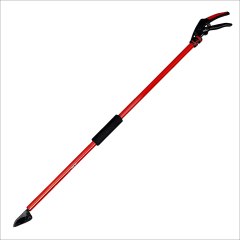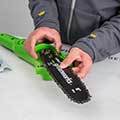Buying guide for best tree pruners
The term “tree pruner” covers a variety of tools: pole saw, lopper, pole pruner, and compound pruner. Each of these serves the same purpose of chopping branches to keep your trees under control, but each requires a different level of skill and strength to use.
Gas and electric pole saws are heavy but work quickly, sawing through branches with sharp motorized blades. Manual pole saws work similarly but rely on you to draw the blade across the branch. Loppers and pruners are also manually powered and have sharp blades that chomp through branches. Lightweight pole pruners have the advantage of an extra-long reach. A compound pruner typically has a saw and pruner on the end of a long, lightweight pole. Each of these pruners has advantages and limits when it comes to reach, branch diameter, and maneuverability.
A tree pruner is a powerful tool that can help you maintain your yard, but choosing the right one can be difficult. Our guide includes our top recommended models and breaks down the different types and their advantages and uses to help you find the perfect tool for your needs.
Key considerations
To find the right type of tree pruner, you should start by considering your needs and your familiarity with pruners. Most tree pruners – even gas-powered and manual ones – cost about the same. That means finding a tree pruner that fits within your budget is easy, but there are many other factors to consider.
Pole saws
Pole saws can be manual, electric, or gas. These tools have a long reach – for most it’s between 8 and 12 feet. While motorized pole saws can cut through branches of up to four inches in diameter, a manual pole saw can only cut through branches of two or three inches in diameter.
Electric pole saws: These are typically less powerful than gas-powered models, but they’re fairly lightweight and easy to use. Cordless pole saws are slightly heavier than corded models and measure their power in volts
Gas pole saws: These tend to be heavier than electric models and can be noisy, but they’re also more powerful. The maintenance on a gas-powered pole saw can be difficult.
Manual pole saws: These are as simple as they sound. They have a blade on the end of a pole that you saw back and forth, just as with a handsaw. Many manual pole saws have catches on both ends of the saw to keep it in place. These saws can be quite challenging to use, especially compared to gas or electric pole saws.
Loppers and pruners
Loppers and pruners are manual blades that you close using two handles. A pruner (or pruning shears) is usually operated with one hand and can handle small branches of an inch or less in diameter. Loppers use the same concept but have much longer handles to give you extra leverage to handle branches of around two inches in diameter. There are a few different kinds of loppers and pruners.
Bypass: A bypass pruner or lopper uses curved blades that pass each other, similar to scissors. These are far sharper than anvil pruners and loppers and should be used when dealing with live branches that could harm the tree if removed roughly.
Anvil: An anvil pruner or lopper has one blade that crushes a branch against an opposing flat piece, called the anvil. This results in a rough cut, making anvil pruners or loppers well suited to quickly shortening branches or cutting dead branches free.
Ratcheting and geared: These loppers have mechanisms to make cutting easier and are a great option for anyone who struggles to close the jaws of regular loppers.
Pole pruners
A pole pruner is the longest pruning tool available. The length combined with the lightweight design of most pole pruners makes one versatile and easy to use. It can be as long as 21 feet, and many are telescoping to reach branches at different heights. Most pole pruners can cut through branches of up to two inches in diameter. Pole pruners are operated by a handle or rope.
Handle: These pole pruners have handle that you squeeze to control the jaws of the bypass or anvil blades.
Rope: These pole pruners use a rope and handle to close the blades and chop through branches. Using this type of pole pruner can take some practice, and the rope can easily get tangled.
Compound pruners
If you want the option of using a pole saw and a pole lopper, look for a compound pruner. These tools have a blade with a lopper, often operated by a rope or handle. The blade is detachable on some models. This is by far the most versatile option when it comes to manual tree pruners.
Expert Tip
Proper pruning can help control a tree’s shape and encourage the growth of healthy branches.
STAFF
BestReviews
Tree pruner features
Weight and balance
The overall weight and balance of a tree pruner can determine how easy it is for you to use. One of the main benefits of using a tree pruner is that you don’t need to use a ladder. You should be able to comfortably hold and operate the tree pruner from the ground. Maintaining control is key to making clean cuts and safely removing branches. Pole pruners, loppers, and shorter pruners are the lightest options.
Reach
Tree pruners vary in reach from half a foot to over 20 feet. You want to choose a tree pruner that can handle most of the trees in your yard, if possible. Bear in mind that this doesn’t just mean finding the longest pruner possible. The pruner should be long enough to reach high branches, but short enough that cutting lower branches isn’t awkward. Many pruners are telescopic, so take note of their minimum and maximum lengths.
Maintenance
Different types of tree pruner require varying levels of maintenance. Electric and gas-powered pole saws require frequent maintenance, including oiling the blades, charging and refueling, and tightening chains. Loppers, pruners, and manual pole saws require sharpening.
Caution
Pruning can be used to remove diseased branches. However, it’s important to disinfect your tools to prevent the disease from spreading to other parts of the tree or other trees.
STAFF
BestReviews
Tree pruner prices
Inexpensive: Most short loppers and pruners fall in the $8 to $30 range. These are well suited to shorter trees with thinner branches.
Mid-range: Tree pruners that cost from $30 to $100 can be pole pruners; compound pruners; or manual or corded electric pole saws. Most tree pruners fall in this range.
Expensive: In the $100 to $200 range are primarily cordless electric and gas-powered pole saws for thicker branches.
Tips
Cutting down branches can be dangerous work. It’s necessary to take several precautions and plan each cut before you make it to keep yourself and others safe.
- Know the right time of year to prune your trees. The right time to prune varies from one type of tree to the next. Trees that bloom in the spring should be pruned shortly after blooming. Non-blooming trees should be pruned in winter when they’re dormant.
- Know where to cut the branches. Cut branches at about a 30° angle either just above the collar, near the tree trunk, or less than an inch above a bud. This ensures that the tree can heal safely and continue to grow as desired.
- Target dead, damaged, and diseased branches first. Removing diseased branches protects the rest of the tree, but the pruner blade should be disinfected before pruning healthy branches.
- Cut pieces off a long branch rather than cutting the whole branch at once. This might mean more work, but it’s also safer.
- Hire a professional for hard-to-reach branches or branches near power lines. Know when a job is too much for you and your tree pruner.
Did you know?
Smaller tree trimmings can be used for compost, while larger branches, once seasoned, can be used as kindling.
STAFF
BestReviews
Other products we considered
If you don’t want an electric or gas-powered tree pruner, there are a handful of models worth mentioning aside from our top picks. For a manual pole saw with impressive reach, the Silky Professional Series Hayauchi Telescopic Pole Saw is a customer favorite. With a maximum length of 21 feet, this saw reaches branches that no motorized pole saw can. For a compound pruner with a pulley system for slicing through tough branches, the Milliard Extendable Tree Pruner/Pole Saw is an affordable choice. While it’s less robust than an all-fiberglass pole, its aluminum frame makes it a lightweight option, and it can handle branches of up to 1.25 inches in diameter. For a basic anvil lopper, we like the Kseibi Extendable Anvil Razor-Edge Lopper, which can extend up to an impressive 40 inches.
FAQ
Q. How do I avoid damaging my trees when I’m pruning?
A. You should prune your trees at the proper time of year, which varies from one type of tree to the next. Most trees can be pruned in winter, while autumn is almost never a good time for pruning. Making a small cut on the underside of a branch before sawing it ensures that the bark won’t peel back as the branch falls.
Q. How often should I prune my trees?
A. It varies with the type of tree, but once about every five years is generally often enough. If you’re unsatisfied with the shape of your trees, you can prune more frequently.
Q. Can you kill a tree by pruning it too often or too much?
A. While an over-pruned tree might not die immediately, improperly pruning a tree by cutting healthy branches or leaving large cuts close to the trunk can expose the tree to insects and disease. These factors can kill the tree over time.
























